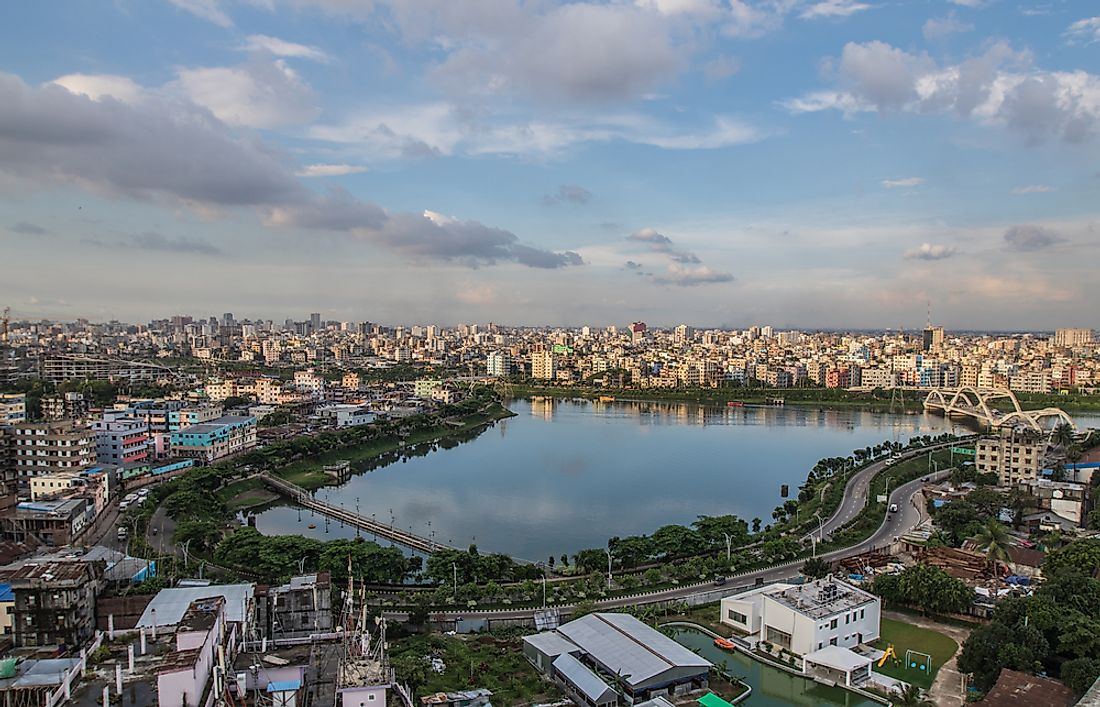What Is The Capital Of Bangladesh?

Bangladesh is a country in South Asia bordering India and Burma covering an area of 148,460 km2 and is slightly smaller than the state of Iowa. The population estimate for 2016 is 156,186,882. Bangladesh in the local language means the country of Bengal with most of the population considering themselves as Bengali. Lying along the east bank of the Buriganga River in the heart of the Bengal delta is Dhaka, the capital of Bangladesh. Dhaka is the largest city in Bangladesh and is the cultural and economic hub of the country.
History Of The Capital Of Bangladesh
The history of the city can be traced to several centuries ago, but it rose to prominence in the 17th century when it was made the capital city of the Mughal dynasty of Bengal between 1608 and 1704. Dhaka also became the center of sea trade and attracted many traders of Armenian, Dutch, English, French, and Portuguese origin. Dhaka has numerous buildings of the past settlement in the region which includes Lal Bagh Fort of 1678 and the tomb of Bibi Pari, the wife of the governor of Bengal who died in 1684. There is also the Bara Katra, or the great caravansary building was used as a shelter by caravans and other traders built in 1684. There is also the Chhota Katra or the small caravansary that was built in 1663, and the religious monument of the Shiite Islam known as the Husayni Dala that was built in 1642. There are other 17th century buildings that dot the city of Dhaka which include the Hindu temple of Dhakeshwari and the Tejgaon Church that was built by the Portuguese among other old buildings.
When the provincial capital of Murshidabad was removed in 1704 coupled with the waning of the Muslin industry, Dhaka was ushered into a period of turn down. It fell under the British rule in 1765, and by 1864 it was made a municipality and continued to lose eminence until it was made the capital of Assam and Eastern Bengal between 1905 and 1912. In the 20th Century, Dhaka became the educational and commercial center. When the British rule ended in the region the city became part of Pakistan and Dhaka was made the capital of East Bengal in 1947 and East Pakistan in 1956. During the war of independence in 1971, Dhaka suffered extensive damage but finally emerged as the capital of Bangladesh.
Contemporary Dhaka
Ever since the city was made the capital of Bangladesh, Dhaka has grown in population, area coverage, and social and economic diversity. Dhaka presently is the most populous and industrialized area in the country. There are different products found in the city which include the traditional jamdani, embroidery, jewelry, and silk. Some of the major industries in the city include pharmaceuticals manufacturing, jute processing, chemical manufacturing, electronic products, leather goods, textiles, and ceramics. A well-developed export-oriented garment industry began towards the end of the 20th century.
Much of the area surrounding Dhaka has plain level terrain bounded by Ganges, Brahmaputra, and Meghna Rivers. There are several streams as well, which include Sitalakya, Dhaleswari, and Buriganga. The important crops in the surrounding area include the rice, sugarcane, jute, and oilseeds. The city of Dakar has different learning institutions which include universities among which are the University of Dakar, Jahanginagar University, and the Bangladesh University of Engineering and Technology. It is also home to different government colleges, national library, nuclear science and research training center, national art gallery, and a museum.
The Population Of The Capital Of Bangladesh
Dhaka is not only the largest city in Bangladesh, but it is also one of the major cities in South Asia. Dhaka is home to an estimated population of about 17 million people and is one of the world’s most densely populated cities in the world. The population of Dhaka city consists of diverse ethnic and religious communities. Dhaka is not only congested and crowded but it also has the biggest traffic congestion and the worst traffic in the world. According to a government report in 2011, traffic in Dhaka could stand still for more than seven hours a day during rush hour.
The Rickshaw Business And Favorite Sport
The Rickshaw is the most popular and convenient means of transportation for short distances in the capital of Bangladesh, making rickshaw art a serious business for the locals in the city. Dhaka Rickshaw art comprises of Hindu gods, bizarre landscapes, local film stars and depictions of Mecca among many others and is a huge tourist attraction. There are a large number of rickshaws in Dhaka and due to the ever-growing competition Rickshaw art is taken seriously. Bangladesh is home to the most favorite sports cricket and the pride of the country. Dhaka is not only home to the national stadium but houses many of Bangladesh's top stars in cricket. Cricket in Dhaka is played almost everywhere including parks, rooftops, roads and even alleys.







